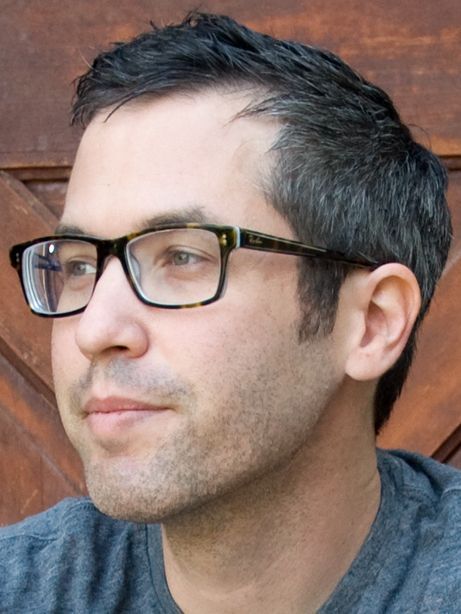
About the Author: When you see the word Rex one immediately imagines a T-rex, but those dangerous creatures are long gone. However, how cool would it be to have the last name Rex? So ladies and gentlemen, girls and boys, I introduce you to Adam Rex, who, unlike a T-Rex, is witty and has a sense of humor.
Adam Rex is a Tucson-based author and illustrator of children’s literature including The True Meaning of Smekday, New York Times Bestselling Frankenstein Makes a Sandwich, and the young-adult novel Fat Vampire. He has been drawing since he was very young and began painting at the age of 11. Rex’s illustrations can be found in the works of Jon Scieszka, Mac Barnett, Neil Gaiman, Jeff Kinney, David Lubar, Kate DiCamillo, Eoin Colfer, Christopher Paul Curtis, and Paul Fieg.
Many fans of the DreamWorks movie, Home (with voice acting by Rihanna, Jim Parsons, Jim Martin, and Jennifer Lopez) might and should know Adam Rex because the movie is based of Rex’s book The True Meaning of Smekday. So, if you liked the movie don’t miss out on reading the book, or if you didn’t like the movie you might like the book much better, because the books are, more often than not, better than their adaptations.
Adam Rex recently was announced as the winner of the second annual Margaret Wise Brown Prize in Children’s Literature. The organization showcases some of the most acclaimed picture book manuscripts which are then judged by a panel. Rex will receive an engraved medal and a $1,000 cash prize for his book School’s First Day of School, illustrated by Christian Robinson and will get published by Roaring Brook Press.
Find Adam Rex on the following platforms:
Adam Rex: I don’t see there being any real drawbacks to digital publishing if they can get the platforms right. I do occasionally hear about e-books that aren’t formatted correctly, or have inexplicably tiny illustrations that you can’t scale. If anything is a limitation, it’s ink and paper. Traditional books can only reproduce a fraction of the color gamut that’s possible on a screen. That said, I still prefer ink and paper. I still like a solid book. But I’m not going to mistake my personal taste for correctness. Technology has always enabled more people to read. The printing press is technology. So is paper.
AR: Well, Zootopia was only a better thought-out version of something Disney’s been doing since the 1920s, right? And I suppose you could say there were Br’er Rabbit stories before that, and Aesop stories way before that. I think we’re still using animals the same way Aesop did—to tell stories about human frailty in such a way as to render them universal and palatable to us frail humans.
AR: I don’t think I do, because I think my style has just changed organically over the years. I do tend to get tired of the idea of rendering my illustrations in the same media and with the same techniques from book to book, however, so I do make a conscious effort to change that up. I’ve made book illustrations out of pencil, oil paint, acrylic paint, gouache, watercolor, charcoal, ink, digital painting, clay, toilet paper, doll clothes, balsa wood, cut-paper dioramas, photography, and probably some stuff I’m forgetting right now.
AR: I very rarely draw first and then write. People do have a tendency to assume that’s how it works, though, which has always interested and confused me. Typically I get an idea for a story, sit down to flesh it out in words, and often only start sketching it out visually after I’ve already sold it to a publisher.
AR: The word “monster,” to both me and, I’d argue, to our culture at large, has at least a couple big competing definitions. The first is something genuinely vicious or terrifying, and the other basically means muppet—cuddly and probably furry, maybe a little gruff but with a heart of gold. Frankenstein embodies both of these to the extent that I actually disagree with people when they get pedantic and try to remind me that, “Actually, it’s Frankenstein’s monster. Frankenstein is the doctor.” No, I say—Frankenstein’s monster is the Byronic, sympathetically Satanic figure in one of the first horror and science fiction stories ever written, and Frankenstein is a goofy green giant who loves hugs or whatever. One is the evolutionary offshoot of the other, and they’re completely different animals now.
AR: Everyday experiences definitely influence both my illustration and writing. You can’t easily sell something fantastic as authentic if you don’t ground it a little.
AR: There was nothing really wacky about it, but I used to talk around an idea for a series about a kid who’s dragged around by his father, his father being a smug James Randi type who’s made it his mission in life to debunk pseudoscience and claims of the paranormal. But the kid is a genuine believer in science and rational thinking, too, and really does think that shining light in the darkness is the best way to approach the world. They travel around, solving mysteries and debunking this and that, with the kid being distressed that their efforts make them pariahs wherever they go because no one will ever love you for telling them they’ve been fooled.
Anyway, it’s either a terrible idea or I just haven’t found the right way to see it, because people hate it.
PRR Writer, Shane Holly